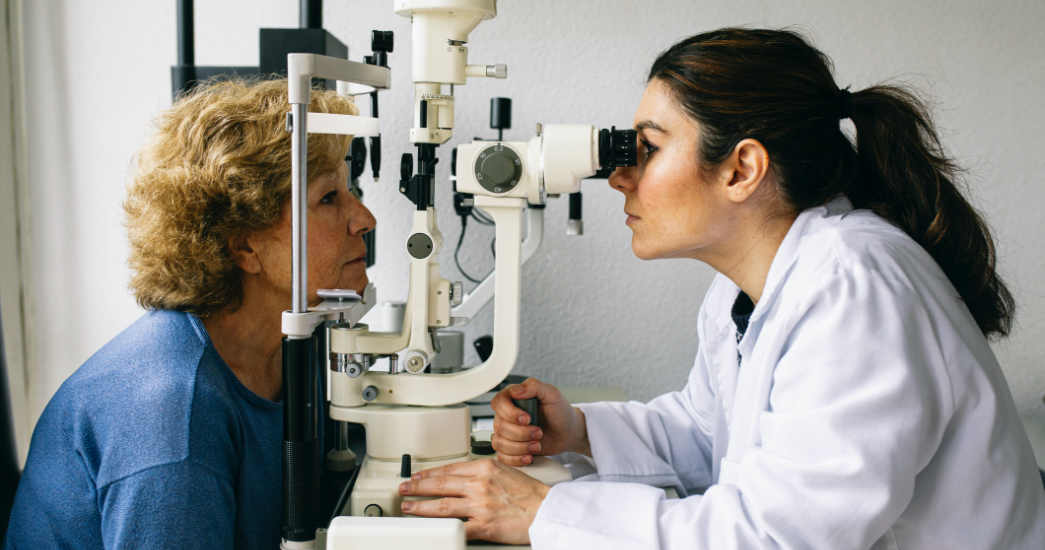
Published July 2021
When thinking about preventive care, an annual physical or dental cleaning may come to mind. Less commonly, though, do people realize their eyes deserve as much attention as the rest of their body. The pandemic exacerbated this problem, as many put off preventative care, including eye exams.
Currently, there are about 93 million adults in the U.S. at high risk for vision loss, due to issues like diabetes or family history of eye disease. But only half of these people have visited an eye care professional this year. Regular eye exams not only determine your need for routine vision correction, but they’re also critical in early detection of common eye diseases, like:
- Age-related macular degeneration — This gradual breakdown of light-sensitive tissue in the eye will eventually blur your central vision.
- Cataracts — The leading cause of vision loss in the U.S., a cataract is the clouding of the eye’s lens.
- Diabetic retinopathy — This disease damages the blood vessels in the back of the eye and is the most common cause of vision loss of diabetics.
- Glaucoma — Glaucoma is a group of diseases that damages the optic nerve, which is located in the back of the eye.
Some of these diseases show no early symptoms, so a comprehensive eye exam is your best defense. The good news is that eye exams are generally simple and painless. Your eye care professional will check to see if you need corrective lenses, but they’ll also check the overall health of your eye. They’ll do this by testing a variety of things, like eye pressure and eye movement, and using drops to widen your pupils (called dilation) to examine the back of your eye.
When should you get your eyes checked?
Frequency of eye exams varies by age and health condition. Children’s eyes are always developing, so it’s important to check in with their pediatrician to learn about the timing of specific screening guidelines. According to the American Academy of Ophthalmology, adults should get exams once in their 20s, twice in their 30s and again when they turn 40, when early signs of disease or changes in vision may occur. Seniors who are 65 and older should have an exam every year or two. However, if you have a medical condition, family history of eye disease or wear contact lenses, you should get personal guidance from your ophthalmologist about how often you need to get your eyes checked. And, of course, if any pain, infection or sudden changes in vision occur, seek immediate attention from an eye care specialist.
What more can you do for those baby blues, browns, grays or greens?
In addition to knowing your family’s eye-health history and getting regular eye exams, there are several lifestyle changes you can make to keep those peepers in tiptop shape.
![]()
Eat healthy. For better eye health, eat plenty of fruits and vegetables. Specifically, beneficial are dark leafy greens and fish high in omega-3 fatty acids.
![]()
Stay in shape. Diabetes (an increased risk when you’re overweight or obese) increases your risk of developing eye disease, which can lead to vision loss. Staying physically active can help minimize the risk.
![]()
Quit smoking. In addition to all the other diseases smoking may cause, it’s also linked to increased risk of several eye conditions that may lead to blindness.
![]()
Rest your eyes. Whether it’s too much screen time or a 1000-piece puzzle, focusing on one thing for too long can cause eyestrain. Try the 20-20-20 rule: Every 20 minutes, look 20 feet in front of you for 20 seconds.
![]()
Wear sunglasses. Protection from ultraviolet rays is not just important for skin, but eyes too. Look for sunglasses that block 99-100% of both UV-A and UV-B rays.
![]()
Keep contact lenses clean. Wash hands thoroughly before putting in or taking out your contact lenses and follow all instructions for proper disinfecting.
Don’t overlook your vision benefits
Your eyes matter. That’s why Harvard Pilgrim offers a variety of vision benefits to help make eye care more affordable and easier to obtain. So, if you’re a member, check to see what’s covered under your current plan. Members also receive discounts and savings on eyewear at multiple locations.
It’s time for eye health to be a priority
From adopting a healthy lifestyle to reducing eye strain, it’s important to give your eyes the love they deserve. If you’re not sure when you last had your eyes checked, now’s the time to catch up on your eye health. Gather any pertinent information on family history of eye disease and choose an eye care professional that’s convenient for you. Make a preventative eye care appointment today.
To confirm eligibility for any programs or services mentioned in this article as it relates to your specific health plan, please reach out to your account executive or HR benefits team. You may also speak to our member services team at (888)-333-4742 or by sending a secure email. And for plan details and other member resources, log in to the member portal.


